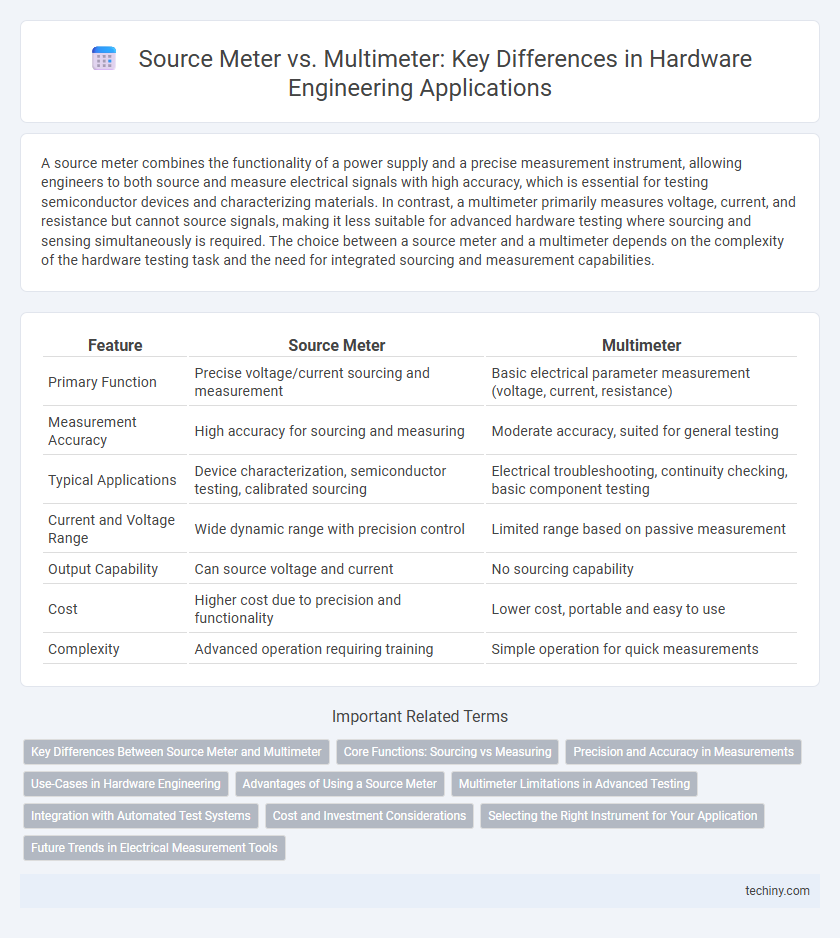A source meter combines the functionality of a power supply and a precise measurement instrument, allowing engineers to both source and measure electrical signals with high accuracy, which is essential for testing semiconductor devices and characterizing materials. In contrast, a multimeter primarily measures voltage, current, and resistance but cannot source signals, making it less suitable for advanced hardware testing where sourcing and sensing simultaneously is required. The choice between a source meter and a multimeter depends on the complexity of the hardware testing task and the need for integrated sourcing and measurement capabilities.
Table of Comparison
| Feature | Source Meter | Multimeter |
|---|---|---|
| Primary Function | Precise voltage/current sourcing and measurement | Basic electrical parameter measurement (voltage, current, resistance) |
| Measurement Accuracy | High accuracy for sourcing and measuring | Moderate accuracy, suited for general testing |
| Typical Applications | Device characterization, semiconductor testing, calibrated sourcing | Electrical troubleshooting, continuity checking, basic component testing |
| Current and Voltage Range | Wide dynamic range with precision control | Limited range based on passive measurement |
| Output Capability | Can source voltage and current | No sourcing capability |
| Cost | Higher cost due to precision and functionality | Lower cost, portable and easy to use |
| Complexity | Advanced operation requiring training | Simple operation for quick measurements |
Key Differences Between Source Meter and Multimeter
A Source Meter combines a precision power supply and a digital multimeter, enabling simultaneous sourcing and measuring of voltage or current with high accuracy, essential for semiconductor testing and characterization. In contrast, a Multimeter primarily measures voltage, current, and resistance but lacks the ability to source power, limiting its use to passive measurement tasks. Source Meters offer advanced functionalities like sweep testing and pulse mode, which are not available in standard multimeters, making them ideal for device parameter analysis.
Core Functions: Sourcing vs Measuring
Source meters combine precision voltage and current sourcing with accurate measurement capabilities, enabling simultaneous output and real-time data acquisition critical for device characterization and component testing. Multimeters primarily function as measuring instruments designed to measure voltage, current, and resistance but lack the ability to source electrical signals. Engineers rely on source meters when precise control of signal input and measurement is essential, whereas multimeters serve general diagnostics and basic measurement tasks.
Precision and Accuracy in Measurements
Source meters provide superior precision and accuracy compared to multimeters by integrating both sourcing and measuring capabilities with fine resolution and low noise levels, essential for semiconductor device testing. Multimeters, while versatile and suitable for general electrical measurements, typically lack the high precision and accuracy required for low-level current and voltage measurements in advanced hardware engineering applications. The advanced calibration and built-in error correction features of source meters ensure consistent, reliable readings crucial for detailed characterization and validation of electronic components.
Use-Cases in Hardware Engineering
Source meters excel in hardware engineering applications that require precise voltage and current sourcing combined with accurate measurement, such as semiconductor device testing and characterization. Multimeters are ideal for general-purpose diagnostics, measuring voltage, current, and resistance in circuits during prototyping and maintenance tasks. Source meters are preferred for automated testing environments where system integration and high accuracy are critical, whereas multimeters offer portability and ease of use for field troubleshooting.
Advantages of Using a Source Meter
Source meters offer precise control over voltage and current, enabling accurate characterization of electronic components and circuits, which multimeters lack. Their integrated sourcing and measuring capabilities minimize test time and improve measurement accuracy in semiconductor testing and device analysis. High resolution and programmability make source meters ideal for automated testing environments and complex hardware engineering applications.
Multimeter Limitations in Advanced Testing
Multimeters, while essential for basic electrical measurements, face limitations in advanced testing due to their lower accuracy and slower response times compared to source meters. They often lack the ability to precisely source and measure current and voltage simultaneously, which is critical for characterizing complex semiconductor devices and materials. Source meters provide integrated sourcing and measuring capabilities with high resolution and precision, making them indispensable for in-depth hardware engineering applications where multimeters fall short.
Integration with Automated Test Systems
Source meters offer precise voltage and current sourcing combined with accurate measurement capabilities, making them ideal for integration in automated test systems where simultaneous sourcing and measuring are required. Multimeters, while versatile for general-purpose measurements, lack the built-in sourcing function and fine control necessary for complex automated testing workflows. Integration with automated test environments benefits significantly from source meters' programmable interfaces and high-speed data acquisition, optimizing test efficiency and accuracy.
Cost and Investment Considerations
Source meters typically involve a higher upfront investment than multimeters due to their advanced functionality integrating both sourcing and measuring capabilities within a single instrument. While multimeters offer cost-effective solutions for basic voltage, current, and resistance measurements, source meters provide precise control and accurate readings essential for semiconductor device testing and characterization. Budgeting for a source meter requires consideration of long-term benefits in testing accuracy and efficiency, often justifying the greater initial expense in hardware engineering applications.
Selecting the Right Instrument for Your Application
Selecting the right instrument between a source meter and a multimeter depends on the specific testing requirements in hardware engineering. Source meters provide precise voltage and current sourcing with simultaneous measurement capability, ideal for semiconductor device characterization and IV curve tracing. Multimeters excel at basic voltage, current, and resistance measurements, offering versatility for general troubleshooting and routine maintenance tasks.
Future Trends in Electrical Measurement Tools
Future trends in electrical measurement tools emphasize integration of Source Meters and Multimeters with advanced AI-driven diagnostics to enhance precision and efficiency in hardware engineering. Emerging technologies focus on improving multivariate analysis and real-time data processing, enabling predictive maintenance and adaptive testing environments. Enhanced connectivity through IoT and cloud-based platforms drives the evolution of these instruments, supporting automated calibration and seamless data sharing across design and manufacturing workflows.
Source Meter vs Multimeter Infographic

 techiny.com
techiny.com